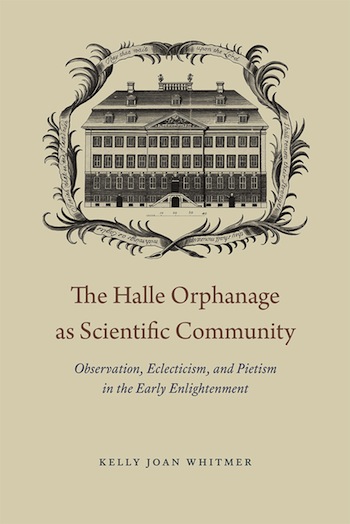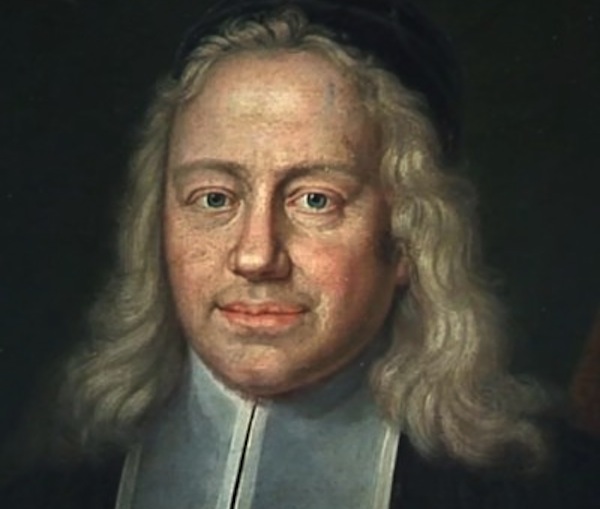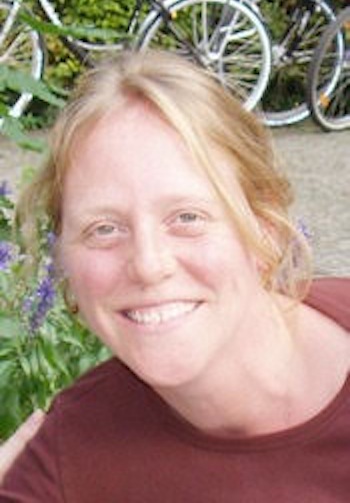Book Review: How Science Fared in the Enlightenment — At the Halle Orphanage
Kelly Joan Whitmer does two things very well: she recounts a vibrant tale of intellectual reform while shining a light on less prominent historical actors in the history of science.
The Halle Orphanage as Scientific Community: Observation, Eclecticism, and Pietism in the Early Enlightenment by Kelly Joan Whitmer, University of Chicago Press, 200 pages, $40.00.
By Justin Grosslight

In 1701, when German clergyman, scholar, and philanthropist August Hermann Francke (1663-1727) became the first director of the Halle Orphanage, his dream was that its ethos would endure. And it has: today, the orphanage is still associated with its founders’ admirable spirit of education, philanthropy, and religious ecumenicalism. Historians have duly noted the institution’s enduring power as well as its early relationship with the Prussian state. It was a place where heads of the German territorial states elucidated their modernizing strategies.
Not as well known is the orphanage’s role as a locus of scientific activity in the early eighteenth century. Kelly Joan Whitmer’s The Halle Orphanage as Scientific Community: Observation, Eclecticism, and Pietism in the Early Enlightenment lucidly explores the orphanage’s forays into accumulating scientific knowledge during its fledgling decades. Whitmer does two things very well: she recounts a vibrant tale of intellectual reform while shining a light on less prominent historical actors in the history of science.
As Whitmer puts it, what was most striking about the Halle Orphanage was how it “filled a… need in central Europe for semipublic venues to hone and refine experimental and observational procedures by acquiring expertise in mathematics and physics as part of a collective.” The institution’s Pietist roots must be given a lion’s share of the credit. At the administrative level, the Orphanage provided a space where Pietists — Germans such as Francke who opposed the Lutheran orthodoxy — could express their ideas in ways that did not overtly challenge the social order.
Intellectual reform was also encouraged by the originating statutes at the newly established University of Halle (founded 1694), which aimed to harmonize its faculties of theology, law, medicine, and philosophy by replacing scholastic teaching and academic disputations with a culture open to pursuing increasingly rational, mechanized lines of inquiry. Buoyed by the support of key intellectuals, including the “Father of Pietism,” Philipp Jakob Spener (1635-1705), both institutions worked to create a space in Halle where eclecticism — the ability to synthesize multiple religious and intellectual viewpoints — could flourish. As Whitmer shows in her opening chapter, this expansion of rational investigation was initially a success: teachers from the University were furnished free lodging at the Orphanage, which expanded its enrollment to 2,200 students from all across Europe in its first few decades.
Ehrenfried Walther von Tschirnhaus (1651-1708) played a key role in creating a Pietist community that valued mathematics. In 1694, shortly after Francke arrived in Halle after securing a teaching job at the University, he and Tschirnhaus began corresponding about running a nearby orphanage. Francke’s associates particularly admired Tschirnhaus’ plans to install glassworks in the building so that students would be able to make their own lenses for optical instruments. Francke relished Tschirnhaus’ Basic Guide to the Useful Sciences, Especially Mathematics and Physics (1708), which encouraged readers to cultivate a mathematical instinct for the sake of helping them comprehend divine messages.
In terms of education, Tschirnhaus advocated a middle way between bookish knowledge and empirical study. Kids were encouraged to use instruments to cultivate a love of the study of mathematics. Tschirnhaus sent a copy of his Basic Guide to mathematical heavyweight Gottfried Wilhelm Leibniz (1646-1716), hoping that Leibniz and Francke would develop a synergistic relationship. Each of the three men believed that the teaching of mathematics needed to be coupled with the use of scientific instruments in ways that would quell spiritual and intellectual conflicts. Together, Leibniz and Francke hoped to use the orphanage model as a way to create a fusion of science and Christianity, hoping to establish Protestant missions abroad, though in the end the two went their own ways.
Whitmer next examines how thinkers at the Halle Orphanage were driven by a spirit of tolerance. Inspired by Lutheran theologian Georg Calixt (1586-1656), who believed that vigorous interfaith discussions on common Christian tenets would help dissolve religious differences, leaders in Brandenburg-Prussia and Berlin worked at promoting open-mindedness (Leibniz and his colleagues, for example, created an interfaith council to support Calixtean views). Along those lines, the Halle Orphanage absorbed into its curriculum the natural philosophy of John Amos Comenius (1592-1670), whose mosaic physics asserted that God’s light, which was spread around the world, needed to be reassembled intuitively rather than through guidelines of a specific creed. At least cognitively, Francke embraced this kind of program: observing virtuous models and reading with rapt contemplation could lead to the accumulation of wisdom though a belief in the power of the mind. Scientifically, this approach meant that Leibniz, Tschirnhaus, and those at the Halle Orphanage sought spiritual and mathematical knowledge by exploring a variety of opinions — including information accumulated through the use of empirical observation and scientific instruments. It was no longer acceptable to understand the world though the imposition of an overarching framework.
This eclectic approach entailed gleaning the best data and reasoning from a number of different perspectives. But despite its initial success, there was a backlash: concerns arose over whether one could opt to exclude certain beliefs entirely. On this matter, the eminent Halle mathematician Christian Wolff (1659-1754) challenged his colleagues at Halle and promoted his own rational framework for understanding God and the world. In doing so, he offended theologian Johann Franz Buddeus (1667-1729), who feared that depending too heavily on reason would create a mechanistic vision of the universe that annulled moral principles. He feared that if traditional ethics were undercut people could advocate their personal beliefs rather than remain open-minded. Responding to Wolff’s threat, Buddeus composed his own Elements of Instrumental and Theoretical Philosophy (both volumes, 1703), an attempt to reinvigorate Comenius’ mosaic physics. Yet the latter’s work – despite its conciliatory nature – was intellectually outmoded: it relied on the Bible for historical information and lacked intense training in applied mathematics. When the Halle Orphanage incorporated Buddeus’ texts into its curriculum (especially after 1721) student exercises in math and astronomy become less of a priority. Moreover, University of Halle theologians increasingly viewed Wolff and his advocacy of rational thought as an aggressive attempt to undermine their authority; the growing rancor likely resulted in Wolff’s expulsion from Halle.
Chapter four recounts how in 1718 educator Christoph Semler (1669-1740) unveiled at the Orphanage an eleven-square-foot wooden model of Solomon’s Temple, an archetypal, divinely-inspired building whose geometry was thought to be sacred. The design of the building’s architecture, unlike the narrowly conceived layouts of his contemporaries, necessarily relied upon a number of texts. Semler’s model was was proudly eclectic, based on the principle of “conciliatory seeing,” whereby one consulted numerous sources to accumulate information in order to create the most accurate version. When conflicts occurred, the only recourse to reconcile dissonant voices was to consider mechanical or architectural precepts. Semler’s methodological mix-and-match moved into challenging territory when it tackled the issue of whether the temple tower contained three or five stories arose. After consulting discordant texts, Semler used his architectural apercu to create a four-story tower with an anomalous interior design. Unsurprisingly, Francke lauded Semler’s methodology because it yielded a model of a religious building based on both rational and empirical guidelines. Semler’s approach exerted influence on Francke’s pedagogical vision of scientific instruments as well; the goal was to inspire children to make their own scientific objects and to encourage teachers to guide their students’ intellectual inquiry in applied mathematics and cosmology.

German clergyman, scholar, and philanthropist August Hermann Francke, who in 1701 became the first director of the Halle Orphanage.
Not all new instruments and their makers proved to be as successful, as in the frustrating case of Halle alumnus and teacher cum administrator Christoph Eberhard (1675-1750). Eberhard developed close relations with Francke while promoting the Halle Orphanage in Denmark, London, and throughout Russia. While traveling, Eberhard cultivated an interest in geomagnetism and created a magnetic inclinator, which measures what is known today (roughly) as magnetic dip. Examining the Earth’s geomagnetism was modish in Eberhard’s era and caught the attention of many literati, including Tsar Peter I (1672-1725). Yet because Eberhard lacked intellectual eminence and ample contacts abroad, he was often rebuffed and even accused of plagiarizing earlier theories of Jesuit François Noël (1651-1729). In reality, Eberhard had created his own geomagnetic theory (similar to the ideas of English geophysicist and astronomer Edmond Halley (1656-1742)), but his overt affiliation with the Halle Orphanage forced him to be discrete when it came to garnering support from networks abroad.
Eberhard’s brand of reasoning was similar to Wolff’s philosophy: ahistorical, mechanical, and axiomatic with proofs. It fell well outside of the purview of mosaic physics. Thus Eberhard became a bête noir in the increasingly scholastic, biblical-historical culture of the Halle community. When Eberhard returned to Halle from his journeys in 1719-1720, he didn’t attempt to find promotional support for his magnetic inclinator from the Orphanage, but from Christian Wolff alone. Wolff, Eberhard hoped, would tout the inclinator to friends in the St. Petersburg scientific academy. Sadly, the Orphanage administration wanted recognition for Eberhard’s inclinator while at the same time denying him credit for inventing the product. The Orphanage capitalized on other peoples’ ideas for its success — whether it agreed with them or not.
Whitmer’s study concludes with a survey of schools modeled after the Halle Orphanage. Orphanages with day schools were erected in Langendorf, Zittau, and Sulechów. Each of their respective founders maintained ties to Halle, amassed considerable donations, and pledged to give children vocational training. In addition, the Sulechów site received support from prominent Prussian families, maintained its own printing press, and, by 1731, had amassed its own impressive collection of scientific objects. Ironically, schools that flourished after Halle’s 1721 curriculum revision rapidly surpassed their progenitor in educational quality. Johann Julius Hecker’s (1707-1768) Berlin Realschule debuted in 1747. Here middling students, soldiers, artists, and craftsmen could pursue practical studies, work with scientific instruments, and take vocational field trips to nearby factories. Also, later administrators in Königsberg’s Collegium Fridericianum, Georg Friedrich Rogall (1701-1733) and Franz Albert Schultz (1692-1763), showed staunch loyalty to the ideas of Christian Wolff, despite The Halle Orphanage’s pressure on them to teach Buddeus’s work. As the eighteenth century progressed, Halle’s influence as an intellectual incubator abated as its curriculum grew increasingly impractical and obsolete.
On the whole, Whitmer’s accomplishments in this book compensate for its few shortcomings. Her research contributes meaningfully to current discussions concerning the history of scientific observation and adds texture to our knowledge of early sites dedicated to institutional science. Recent work by Lorraine Daston shows that, beginning in the eighteenth century, the practice of scientific observation shifted from being localized (often at the same site) sequences of particular experiments to becoming more collective and widespread with more elaborate data gathering effort. Of course, this required increased emphasis on training people how to observe. Historians of science have long considered natural history, astronomy, and medicine as loci of change in this activity. By focusing on mathematical instruments and their relationship to the Orphanage curriculum (along with increasingly coordinated efforts to study geomagnetism), Whitmer dramatizes how the success of a particular pedagogical program dedicated to training scientific observers widened the scope of observational practices.
In terms of its historical value as an institution, the Halle Orphanage system is provocative in at least two ways. On one level, the Orphanage and its progeny can be seen as a Lutheran analog to the Jesuit Collegio Romano and its subordinate outposts. Both the Orphanage and Jesuit systems trained mathematicians, entertained expansionist missionary interests, used scientific instruments far afield from their schools, and dispatched star scholars from a hub school to manage satellite branches. Understanding the Orphanage in this light suggests that selected Protestants — much like their Catholic rivals — took important steps to coordinate and institutionalize scientific endeavors. Even more exciting is that the Orphanage’s eclectic values promoted the value of a plurality of religious viewpoints. Historians have long known that science can flourish within and across different religious contexts, but little has been said about how support from conflicting religious backgrounds can help generate rational and empirical knowledge. By underscoring the virtues of eclecticism and its Pietist roots, Whitmer has taken discussion of the early relationship between science and religion to a new level.

Kelly Joan Whitmer. Photo: Courtesy of the author.
Also, many of the characters in Whitmer’s narrative are seen through refreshingly revisionist lenses. Casting Pietism as scientifically inquisitive rather than as fount of religious fervor puts Francke’s wide-ranging intellectual values front and center. Readers also gain a new perspective on Christian Wolff. Whitmer contends that he wasn’t expelled from Halle because of his 1721 speech “On the Practical Philosophy of the Chinese,” but because of his sustained commitment to rationalist thinking. Placing Wolff in Halle’s intellectual context complements what historians of science know of him already as a philosopher and as recruitment conduit for the St. Petersburg academy. The book also assesses Leibniz’s relationship with the Halle community, thus helping researchers see the man more clearly, outside of the stereotypical context of calculating machines, the Berlin Academy, and calculus wars with mathematician Isaac Newton (1643-1727). When read along with work by Dániel Margócsy (Arts Fuse review here), Adelheid Voskuhl, Michael Hunter, and others, Whitmer’s book takes its place among the recent spate of books that highlight the diverse manifestations of scientific culture in Enlightenment Europe.
Despite its successes, Whitmer’s book is methodologically modest. She neither challenges major theoretical frameworks in the history of science nor provides new lenses through which historians of science can interpret the growth of theoretical ideas. Scholarship that examines the importance of place in history of science has been a major research topic for quite awhile: for example, Steven Shapin and Simon Schaffer’s classic work on the Royal Society as well as Mario Biagioli’s analysis of Galileo at court. Extensive studies of scientific academies, laboratories, personal households, field trips, universities, and Jesuit outposts have already mushroomed. Numerous papers also have examined the relationship between particular actors, their scientific instruments, and their environments. Whitmer’s chapter on Eberhard, for example, doesn’t expand theoretical boundaries other than to stress the importance of magnetism in the Enlightenment.
A few subtler points are also troubling. Whitmer notes that, in the early eighteenth century, the Halle Orphanage, University of Halle, and Berlin Academy “grew more self-sufficient and disconnected from each other.” In truth, the Berlin Academy floundered during its initial years because the court of King Friedrich I (1657-1713) siphoned off its funding, while his successor Friedrich Wilhelm I (1688-1740) remained hostile to the idea of a scientific society. Though founded in 1701 with Leibniz as President, the thinker did not receive this designation in the Berlin Academy’s official inaugural charter of 1710. The waning of the epistolary communication between Francke and Leibniz after 1699 can at least partially be explained by Leibniz’s preoccupation with starting up the academy. It would also be interesting to know to what extent, if any, the Halle Orphanage was aware of the piston-type air pump and electrostatic experiments of the well-known German polymath and physicist Otto von Guericke (1602-1686). In the generation prior to the Orphanage’s establishment, Guericke was one of the most prominent physics experimenters in the Holy Roman Empire, and air pump demonstrations were part of the Orphanage’s program.
Still, minor reservations aside, Whitmer packs a lot of information into 200 pages. Via meticulous scholarship and fabulous illustrations, she explores, with nuance, how religious and intellectual energies intertwined in ways that galvanized mathematical practice. By highlighting the interplay among individual beliefs, actions, and scientific achievements, her book resuscitates the careers of such understudied figures as Francke, Wolff, and Leibniz in history of science scholarship. Readers curious about the evolution of scientific culture should cherish this book’s revelatory spotlight on an important niche in the Enlightenment.
Justin Grosslight is an academic entrepreneur interested in examining relationships between science and business. He is especially intrigued by how networks operate (quantitatively and qualitatively), both from historical and from contemporary perspectives. He holds degrees in history and mathematics from Stanford, a history of science degree from Harvard, and has published in all three fields. He currently is working in Vietnam, but also has lived in Italy and the United States.
